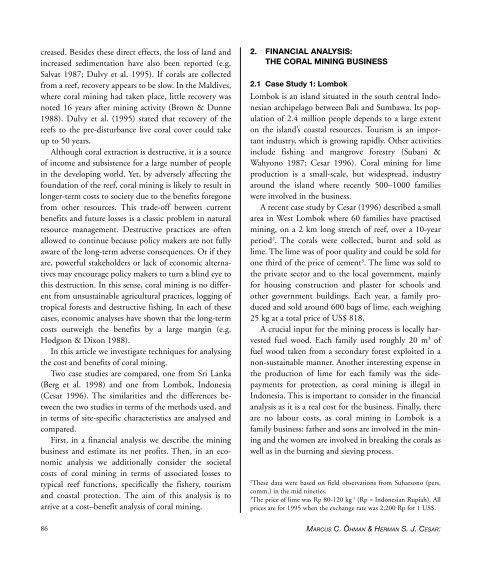You also want an ePaper? Increase the reach of your titles
YUMPU automatically turns print PDFs into web optimized ePapers that Google loves.
creased. Besides these direct effects, the loss <strong>of</strong> land and<br />
increased sedimentation have also been reported (e.g.<br />
Salvat 1987; Dulvy et al. 1995). If corals are collected<br />
from a reef, recovery appears to be slow. In the Maldives,<br />
where coral mining had taken place, little recovery was<br />
noted 16 years after mining activity (Brown & Dunne<br />
1988). Dulvy et al. (1995) stated that recovery <strong>of</strong> the<br />
reefs to the pre-disturbance live coral cover could take<br />
up to 50 years.<br />
Although coral extraction is destructive, it is a source<br />
<strong>of</strong> income and subsistence for a large number <strong>of</strong> people<br />
in the developing world. Yet, by adversely affecting the<br />
foundation <strong>of</strong> the reef, coral mining is likely to result in<br />
longer-term costs to society due to the benefits foregone<br />
from other resources. This trade-<strong>of</strong>f between current<br />
benefits and future losses is a classic problem in natural<br />
resource management. Destructive practices are <strong>of</strong>ten<br />
allowed to continue because policy makers are not fully<br />
aware <strong>of</strong> the long-term adverse consequences. Or if they<br />
are, powerful stakeholders or lack <strong>of</strong> economic alternatives<br />
may encourage policy makers to turn a blind eye to<br />
this destruction. In this sense, coral mining is no different<br />
from unsustainable agricultural practices, logging <strong>of</strong><br />
tropical forests and destructive fishing. In each <strong>of</strong> these<br />
cases, economic analyses have shown that the long-term<br />
costs outweigh the benefits by a large margin (e.g.<br />
Hodgson & Dixon 1988).<br />
In this article we investigate techniques for analysing<br />
the cost and benefits <strong>of</strong> coral mining.<br />
Two case studies are compared, one from Sri Lanka<br />
(Berg et al. 1998) and one from Lombok, Indonesia<br />
(Cesar 1996). The similarities and the differences between<br />
the two studies in terms <strong>of</strong> the methods used, and<br />
in terms <strong>of</strong> site-specific characteristics are analysed and<br />
compared.<br />
First, in a financial analysis we describe the mining<br />
business and estimate its net pr<strong>of</strong>its. Then, in an economic<br />
analysis we additionally consider the societal<br />
costs <strong>of</strong> coral mining in terms <strong>of</strong> associated losses to<br />
typical reef functions, specifically the fishery, tourism<br />
and coastal protection. The aim <strong>of</strong> this analysis is to<br />
arrive at a cost–benefit analysis <strong>of</strong> coral mining.<br />
2. FINANCIAL ANALYSIS:<br />
THE CORAL MINING BUSINESS<br />
2.1 Case Study 1: Lombok<br />
Lombok is an island situated in the south central Indonesian<br />
archipelago between Bali and Sumbawa. Its population<br />
<strong>of</strong> 2.4 million people depends to a large extent<br />
on the island’s coastal resources. Tourism is an important<br />
industry, which is growing rapidly. Other activities<br />
include fishing and mangrove forestry (Subani &<br />
Wahyono 1987; Cesar 1996). <strong>Coral</strong> mining for lime<br />
production is a small-scale, but widespread, industry<br />
around the island where recently 500–1000 families<br />
were involved in the business.<br />
A recent case study by Cesar (1996) described a small<br />
area in West Lombok where 60 families have practised<br />
mining, on a 2 km long stretch <strong>of</strong> reef, over a 10-year<br />
period 2 . The corals were collected, burnt and sold as<br />
lime. The lime was <strong>of</strong> poor quality and could be sold for<br />
one third <strong>of</strong> the price <strong>of</strong> cement 3 . The lime was sold to<br />
the private sector and to the local government, mainly<br />
for housing construction and plaster for schools and<br />
other government buildings. Each year, a family produced<br />
and sold around 600 bags <strong>of</strong> lime, each weighing<br />
25 kg at a total price <strong>of</strong> US$ 818.<br />
A crucial input for the mining process is locally harvested<br />
fuel wood. Each family used roughly 20 m 3 <strong>of</strong><br />
fuel wood taken from a secondary forest exploited in a<br />
non-sustainable manner. Another interesting expense in<br />
the production <strong>of</strong> lime for each family was the sidepayments<br />
for protection, as coral mining is illegal in<br />
Indonesia. This is important to consider in the financial<br />
analysis as it is a real cost for the business. Finally, there<br />
are no labour costs, as coral mining in Lombok is a<br />
family business: father and sons are involved in the mining<br />
and the women are involved in breaking the corals as<br />
well as in the burning and sieving process.<br />
2<br />
These data were based on field observations from Suharsono (pers.<br />
comm.) in the mid nineties.<br />
3<br />
The price <strong>of</strong> lime was Rp 80-120 kg -1 (Rp = Indonesian Rupiah). All<br />
prices are for 1995 when the exchange rate was 2,200 Rp for 1 US$.<br />
86<br />
MARCUS C. ÖHMAN & HERMAN S. J. CESAR:


















